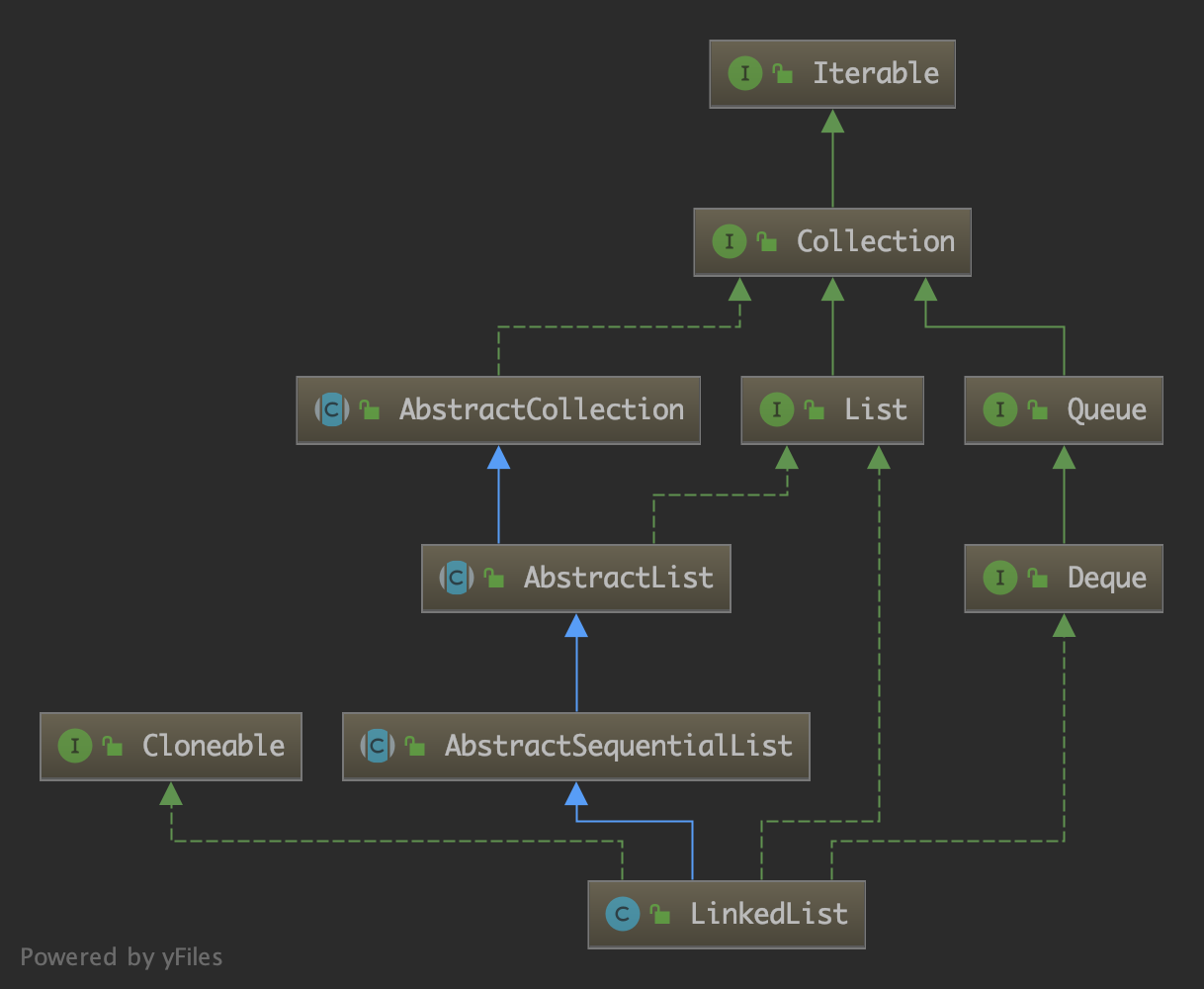概述
相较于 ArrayList,LinkedList 在平时使用少一些。
LinkedList 内部是一个双向链表,并且实现了 List 接口和 Deque 接口,因此它也具有 List 的操作以及双端队列和栈的性质。双向链表的结构如下:

前文分析了 Queue 和 Deque 接口,正是因为 LinkedList 实现了 Deque 接口。LinkedList 的继承结构如下:

结点类 Node
查看 LinkedList 的源码可发现它内部有个嵌套类 Node,代码如下:
private static class Node<E> { E item; // 存储的数据 Node<E> next; // 后继结点 Node<E> prev; // 前驱结点 Node(Node<E> prev, E element, Node<E> next) { this.item = element; this.next = next; this.prev = prev; } }
LinkedList 是双向链表的实现,而该 Node 类则是链表的结点。
此外,LinkedList 还有几个成员变量如下:
// list 的长度 transient int size = 0; // 链表头结点 transient Node<E> first; // 链表尾结点 transient Node<E> last;
构造器
LinkedList 有两个构造器,如下:
public LinkedList() { } public LinkedList(Collection<? extends E> c) { this(); addAll(c); }
PS: 由于链表的容量可以一直增加,因此没有指定容量的构造器。
其中第一个为无参构造器;第二个为使用指定的集合构造,并调用 addAll(),继续跟进该方法,代码如下:
public boolean addAll(Collection<? extends E> c) { return addAll(size, c); } public boolean addAll(int index, Collection<? extends E> c) { checkPositionIndex(index); // 将集合元素转为数组 Object[] a = c.toArray(); int numNew = a.length; if (numNew == 0) return false; // 获取当前链表的前驱和后继结点 Node<E> pred, succ; if (index == size) { // 尾结点的前驱和后继结点 succ = null; pred = last; } else { // 若非尾结点,获取指定位置的结点 succ = node(index); pred = succ.prev; } // 循环将数组中的元素插入到链表 for (Object o : a) { @SuppressWarnings("unchecked") E e = (E) o; Node<E> newNode = new Node<>(pred, e, null); if (pred == null) first = newNode; else pred.next = newNode; pred = newNode; } // 若插入到末尾,则数组中的最后一个元素就是尾结点 if (succ == null) { last = pred; } else { // 若插入到指定位置,将数组中最后一个元素与下一个位置关联起来 pred.next = succ; succ.prev = pred; } size += numNew; modCount++; return true; }
其中 node(index) 方法为获取指定位置的结点,代码如下:
Node<E> node(int index) { // assert isElementIndex(index); // 若下标在前一半,则从前往后遍历;否则从后往前遍历 if (index < (size >> 1)) { Node<E> x = first; for (int i = 0; i < index; i++) x = x.next; return x; } else { Node<E> x = last; for (int i = size - 1; i > index; i--) x = x.prev; return x; } }
该方法通过遍历链表获取指定的元素。
值得注意的是,该方法并非直接从头到尾遍历整个链表,而是先判断下标的位置,若在前一半则从前往后遍历;否则就从后往前遍历。这样能减少遍历结点的个数。
PS: 前文「数据结构与算法笔记(一)」对链表进行过分析,由于其内存空间非连续,因此不支持随机访问(下标访问)。所以,查询某个结点是通过遍历整个链表来实现的。
与此同时,get(index) 方法内部也是这样实现的:
public E get(int index) { checkElementIndex(index); return node(index).item; }
常用方法
之前分析 Queue 和 Deque 的时候提到:Queue 中的方法在 Deque 中都有对应的。下面简单分析 LinkedList 中一些常用的方法。
新增结点方法:add(), addLast(), offerLast()
public boolean offerLast(E e) { addLast(e); return true; } public void addLast(E e) { linkLast(e); } public boolean add(E e) { linkLast(e); return true; }
可以看到他们都是调用了同一个方法 linkLast(e) 实现的,如下:
void linkLast(E e) { final Node<E> l = last; final Node<E> newNode = new Node<>(l, e, null); last = newNode; // 若链表为空,则新结点为头结点 if (l == null) first = newNode; // 若链表不为空,将新结点插入到链表尾部 else l.next = newNode; size++; modCount++; }
该操作就是将指定的结点添加到链表末尾。
删除结点方法:poll(), pollFirst(), removeFirst()
public E poll() { final Node<E> f = first; return (f == null) ? null : unlinkFirst(f); } public E pollFirst() { final Node<E> f = first; return (f == null) ? null : unlinkFirst(f); } public E removeFirst() { final Node<E> f = first; if (f == null) throw new NoSuchElementException(); return unlinkFirst(f); }
可以看到这三个方法都是调用 unlinkFirst() 方法实现的,其代码如下:
private E unlinkFirst(Node<E> f) { // assert f == first && f != null; final E element = f.item; final Node<E> next = f.next; f.item = null; f.next = null; // help GC first = next; if (next == null) last = null; else next.prev = null; size--; modCount++; return element; }
该方法的操作就是从链表头部移除一个结点。
向单链表插入和删除结点的操作示意图如下(双链表比这里多了前驱结点):

栈的入栈(push)和出栈(pop)操作:
public void push(E e) { addFirst(e); } public E pop() { return removeFirst(); }
可以看到这两个方法直接调用了双端队列的实现方法。即,该栈是一个「链式栈」。
线程安全性
线程安全的概念不再赘述。分析以下场景:
若有线程 T1 对 LinkedList 进行遍历,同时线程 T2 对其进行结构性修改。
对 LinkedList 的遍历是通过 listIterator(index) 方法实现的,如下:
public ListIterator<E> listIterator(int index) { checkPositionIndex(index); return new ListItr(index); } private class ListItr implements ListIterator<E> { private Node<E> lastReturned; private Node<E> next; private int nextIndex; // 初始化时二者是相等的 private int expectedModCount = modCount; ListItr(int index) { // assert isPositionIndex(index); next = (index == size) ? null : node(index); nextIndex = index; } public E next() { checkForComodification(); if (!hasNext()) throw new NoSuchElementException(); lastReturned = next; next = next.next; nextIndex++; return lastReturned.item; } public void remove() { checkForComodification(); if (lastReturned == null) throw new IllegalStateException(); Node<E> lastNext = lastReturned.next; unlink(lastReturned); if (next == lastReturned) next = lastNext; else nextIndex--; lastReturned = null; expectedModCount++; } // ... // 是否有其他线程对当前对象进行结构修改 final void checkForComodification() { if (modCount != expectedModCount) throw new ConcurrentModificationException(); } }
该类的 next(), add(e) 等方法在执行时会检测 modCount 与创建时是否一致(checkForComodification() 方法),从而判断是否有其他线程对该对象进行了结构修改,若有则抛出 ConcurrentModificationException 异常。
因此,LinkedList 是线程不安全的。
小结
1. LinkedList 内部是「双向链表」,同时实现了 List 接口和 Deque 接口,因此也具备 List、双端队列和栈的性质;
2. 线程不安全。
Stay hungry, stay foolish.

PS: 本文首发于微信公众号。